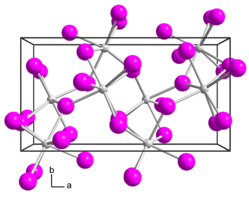 | |
| Names | |
|---|---|
| Other names Ytterbium dibromide | |
| Identifiers | |
3D model (JSmol) | |
| ChemSpider | |
PubChem CID | |
CompTox Dashboard (EPA) | |
| |
| |
| Properties | |
| Br2Yb | |
| Molar mass | 332.853 g·mol−1 |
| Appearance | pale yellow solid |
Except where otherwise noted, data are given for materials in their standard state (at 25 °C [77 °F], 100 kPa). | |
Ytterbium(II) bromide is an inorganic compound with the chemical formula YbBr2.